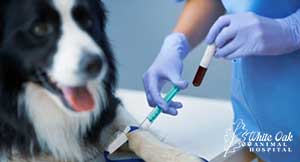
Canine Distemper is a highly contagious viral disease that poses a significant threat to the health of dogs. This disease is caused by the Canine Distemper virus (CDV), a member of the Morbillivirus family. It primarily affects the respiratory, gastrointestinal, and nervous systems of dogs, leading to a range of symptoms that can vary in severity.
Canine Distemper can result in fever, coughing, nasal discharge, lethargy, loss of appetite, and even neurological symptoms like seizures and muscle twitches. The significance of Canine Distemper in dog health cannot be overstated. It not only causes considerable suffering in infected dogs but can also be fatal, especially in puppies and dogs with weakened immune systems. You need to be informed about the symptoms of the disease, as early detection plays a pivotal role in successful treatment.
What is Canine Distemper?
Canine Distemper is a highly contagious viral disease that poses a significant threat to the health of dogs. This disease is caused by the Canine Distemper Virus (CDV), which belongs to the Morbillivirus family. CDV primarily targets the respiratory, gastrointestinal, and nervous systems, leading to a wide range of symptoms and potential complications.
 The Canine Distemper Virus is transmitted through direct contact with infected bodily fluids, including respiratory secretions and urine, as well as through contaminated objects and surfaces. Puppies and dogs with weakened immune systems are particularly susceptible to the virus. Once infected, the virus rapidly spreads through the lymphatic system, targeting various organs and causing inflammation.
The Canine Distemper Virus is transmitted through direct contact with infected bodily fluids, including respiratory secretions and urine, as well as through contaminated objects and surfaces. Puppies and dogs with weakened immune systems are particularly susceptible to the virus. Once infected, the virus rapidly spreads through the lymphatic system, targeting various organs and causing inflammation.
The severity of Canine Distemper can vary, ranging from mild cases with only respiratory symptoms to severe cases that involve neurological issues and even death. Initial symptoms may include fever, nasal discharge, coughing, and loss of appetite. As the virus progresses, more severe symptoms like vomiting, diarrhea, neurological signs such as seizures and muscle twitching, and even paralysis can occur.
The impact of Canine Distemper on a dog’s health can be devastating. The virus attacks the immune system, leaving the dog vulnerable to secondary infections. Neurological symptoms can lead to permanent damage, affecting the dog’s quality of life. Additionally, while some dogs may recover with proper medical care, others might succumb to the disease, especially if their immune response is compromised.
Primary Characteristics and Symptoms of Canine Distemper
 Canine Distemper manifests through a range of primary characteristics and symptoms, underscoring its impact on both the respiratory and gastrointestinal systems. This highly contagious disease caused by the Canine Distemper virus (CDV) can exhibit a variety of signs, with severity ranging from mild to severe. Respiratory symptoms are often among the initial indicators of Canine Distemper. Dogs affected by the virus may develop a persistent cough, along with nasal discharge that is usually thick and mucous-like. As the disease progresses, respiratory distress can become evident, resulting in labored breathing.
Canine Distemper manifests through a range of primary characteristics and symptoms, underscoring its impact on both the respiratory and gastrointestinal systems. This highly contagious disease caused by the Canine Distemper virus (CDV) can exhibit a variety of signs, with severity ranging from mild to severe. Respiratory symptoms are often among the initial indicators of Canine Distemper. Dogs affected by the virus may develop a persistent cough, along with nasal discharge that is usually thick and mucous-like. As the disease progresses, respiratory distress can become evident, resulting in labored breathing.
Gastrointestinal symptoms are also common, with dogs experiencing lethargy and a notable decrease in appetite. Vomiting and diarrhea are frequently observed, contributing to dehydration and overall weakness. In some cases, gastrointestinal symptoms might dominate the clinical presentation of the disease. The virus’s impact isn’t limited to these systems; it can also affect the central nervous system. Neurological symptoms may include muscle twitches, seizures, and even paralysis. These signs are indicative of the virus’s ability to invade and damage the nervous tissue.
It’s important to note that the severity of Canine Distemper symptoms can vary widely. Some dogs may exhibit only mild respiratory signs, while others may display severe neurological symptoms that significantly impair their quality of life. Puppies and dogs with weaker immune systems are particularly susceptible to more severe manifestations. Given the diverse nature of symptoms and their potential to escalate rapidly, early detection and prompt veterinary intervention are essential. Regular vaccinations are the best preventive measure against Canine Distemper, significantly reducing the risk of infection. By staying vigilant, understanding the symptoms, and seeking timely medical attention, dog owners can ensure the health and well-being of their beloved pets in the face of this serious viral disease.
Understanding the Spread of Canine Distemper Virus
 Canine Distemper is primarily transmitted through the airborne route, posing a significant risk through exposure to infected respiratory secretions. The virus can be released into the environment when infected dogs cough, sneeze, or even breathe. This makes close proximity to infected animals a potential source of transmission. Direct contact with infected dogs amplifies the risk of virus transmission. Greetings involving sniffing and licking can lead to viral particles being exchanged. Shared water bowls, food dishes, and toys can serve as fomites, allowing the virus to linger on surfaces and facilitating its spread to other dogs.
Canine Distemper is primarily transmitted through the airborne route, posing a significant risk through exposure to infected respiratory secretions. The virus can be released into the environment when infected dogs cough, sneeze, or even breathe. This makes close proximity to infected animals a potential source of transmission. Direct contact with infected dogs amplifies the risk of virus transmission. Greetings involving sniffing and licking can lead to viral particles being exchanged. Shared water bowls, food dishes, and toys can serve as fomites, allowing the virus to linger on surfaces and facilitating its spread to other dogs.
Contaminated surfaces, such as floors, walls, and even grooming tools, can harbor the virus for extended periods. Unvaccinated dogs that come into contact with these contaminated surfaces are at heightened risk of infection. The high contagiousness of Canine Distemper is a stark reality. It’s estimated that up to 90% of unvaccinated dogs in close contact with infected animals will contract the virus.
Diagnostic Methods and Treatment Options
 Diagnostic methods employed by veterinarians to detect Canine Distemper encompass a comprehensive approach. A thorough physical examination is often the initial step, where symptoms such as fever, nasal discharge, and coughing are assessed. Blood tests play a pivotal role, revealing the presence of antibodies or the virus itself, aiding in definitive diagnosis. Early diagnosis is paramount for effective treatment. Detecting the virus in its early stages allows for timely intervention, minimizing the severity of symptoms and potential complications.
Diagnostic methods employed by veterinarians to detect Canine Distemper encompass a comprehensive approach. A thorough physical examination is often the initial step, where symptoms such as fever, nasal discharge, and coughing are assessed. Blood tests play a pivotal role, revealing the presence of antibodies or the virus itself, aiding in definitive diagnosis. Early diagnosis is paramount for effective treatment. Detecting the virus in its early stages allows for timely intervention, minimizing the severity of symptoms and potential complications.
Veterinarians rely on these diagnostic tools to make informed decisions regarding treatment strategies. Treatment for Canine Distemper centers on supportive care. Since there’s no cure for the virus itself, the focus shifts to managing symptoms and preventing secondary infections. Medications may be administered to alleviate fever, reduce coughing, and relieve discomfort. Antibiotics are often prescribed to ward off bacterial infections that could take advantage of the weakened immune system.
IV fluids play a critical role in maintaining hydration and electrolyte balance, particularly when a dog is experiencing loss of appetite, vomiting, or diarrhea. These fluids also help the body fight the virus and recover more effectively. In some cases, antiviral medications may be considered, although their efficacy varies and they’re not a definitive solution. Preventive measures, including proper vaccination and avoiding exposure to infected animals, remain the best defense against Canine Distemper.
Effective Preventive Measures
Effective preventive measures play a crucial role in safeguarding dogs from the threat of Canine Distemper. Foremost among these measures is vaccination, which stands as a powerful shield against this contagious viral disease. Vaccination stimulates the dog’s immune system to produce antibodies that can combat the Canine Distemper virus (CDV) effectively. Regular and timely vaccinations significantly reduce the risk of infection and the severity of symptoms. In addition to vaccination, practicing proper hygiene is essential.
 Regularly cleaning and disinfecting living spaces, bedding, and shared items helps minimize the chances of virus transmission. Ensuring dogs have access to clean water and a balanced diet supports their overall health, making them better equipped to resist infections. Regular veterinary check-ups are another integral facet of prevention. Veterinarians can monitor a dog’s health, administer vaccinations on schedule, and address any emerging concerns promptly. These visits also provide an opportunity to discuss preventive strategies tailored to the dog’s lifestyle and potential exposure risks. Avoiding contact with infected dogs is paramount.
Regularly cleaning and disinfecting living spaces, bedding, and shared items helps minimize the chances of virus transmission. Ensuring dogs have access to clean water and a balanced diet supports their overall health, making them better equipped to resist infections. Regular veterinary check-ups are another integral facet of prevention. Veterinarians can monitor a dog’s health, administer vaccinations on schedule, and address any emerging concerns promptly. These visits also provide an opportunity to discuss preventive strategies tailored to the dog’s lifestyle and potential exposure risks. Avoiding contact with infected dogs is paramount.
Restricting interactions with dogs displaying symptoms, or even those with uncertain vaccination status, can reduce the risk of transmission. Shared water bowls and communal spaces should be approached with caution, especially in areas where the disease is prevalent. Vaccination holds an additional advantage beyond individual protection – it contributes to herd immunity. When a significant portion of the dog population is vaccinated, the spread of the virus slows down, protecting vulnerable animals and diminishing the overall prevalence of Canine Distemper.
Vigilance is key. Consulting veterinarians is essential when symptoms emerge. A veterinarian’s expertise can lead to accurate diagnosis and appropriate treatment, which often involves supportive care, medication, and antibiotics to prevent secondary infections. We encourage dog owners to consider White Oak Animal Hospital for the best possible care. With over 28 years of experience and a track record of treating over 6,000 pets, White Oak Animal Hospital stands as a reliable partner in pet health. Their integrative options, including TCVM Telemedicine consultations, offer a comprehensive approach to addressing Canine Distemper and other health concerns. Choosing White Oak Animal Hospital is a proactive step towards ensuring the well-being of your furry companion.
Related Posts
-
Understanding Dog Cushing's Disease Treatments
Once your pet has been diagnosed, talk with your vet about options for dog Cushing’s…
-
Benefits Of Natural Herbs For Dog Dandruff
Does your pup have dog dandruff? Additionally, they may also have: Occasional dry, lusterless coat…
-
Learn How To Alleviate Dog Leg Pain Naturally
Dog arthritis is the top cause of chronic dog leg pain. Arthritis affects approximately 20%…
-
Learn How to Alleviate Dog Tremors Naturally
Dog tremors are sometimes mistaken for dog seizures. Consult your veterinarian to confirm whether your…









